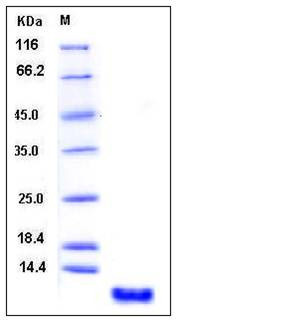Human S100P / S100E Protein
MIG9
- 100ug (NPP4241) Please inquiry
| Catalog Number | P12635-HNAE |
|---|---|
| Organism Species | Human |
| Host | E. coli |
| Synonyms | MIG9 |
| Molecular Weight | The recombinant human S100P consisting of 95 amino acids and has a calculated molecular mass of 10.4 kDa. |
| predicted N | Met 1 |
| SDS-PAGE |  |
| Purity | > 97 % as determined by SDS-PAGE |
| Protein Construction | A DNA sequence encoding the mature form of human S100P (P25815) (Met 1-Lys 95) was expressed and purified. |
| Bio-activity | |
| Research Area | Immunology |Signal Transduction |Calcium-binding Proteins and Related Molecules |
| Formulation | Lyophilized from sterile PBS, pH 7.5 1. Normally 5 % - 8 % trehalose and mannitol are added as protectants before lyophilization. Specific concentrations are included in the hardcopy of COA. |
| Background | Protein S100-P, also known as Protein S100-E, S100 calcium-binding protein P, S100P and S100E, is a nucleus and cytoplasm protein which belongs to the S-100 family. S100P / S100E contains two EF-hand domains. S100P protein regulates calcium signal transduction and mediates cytoskeletal interaction, protein phosphorylation and transcriptional control. S100P / S100E overexpression can upregulate androgen receptor expression and thereby promote prostate cancer progression by increasing cell growth. S100P / S100E may directly confer resistance to chemotherapy. S100P / S100E induction may be considered an important step in the initial stage of lung adenocarcinomas, whereas its downregulation in advanced stages seems to be important for tumour progression in which DNA methylation and/or feedback transcription processes play a critical role. S100P / S100E plays a major role in the aggressiveness of pancreatic cancer that is likely mediated by its ability to activate RAGE. Interference with S100P / S100E may provide a novel approach for treatment of pancreatic cancer. S100P / S100E could be considered a potential drug target or a chemosensitization target, and could also serve as a biomarker for aggressive, hormone-refractory and metastatic prostate cancer. |
| Reference |
